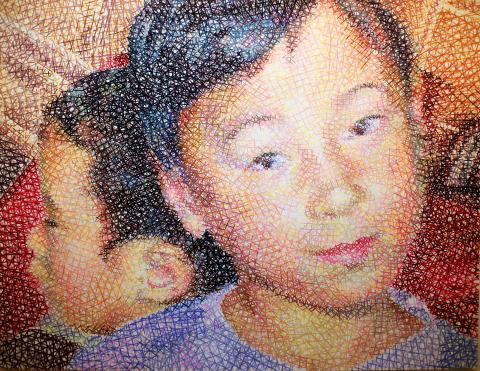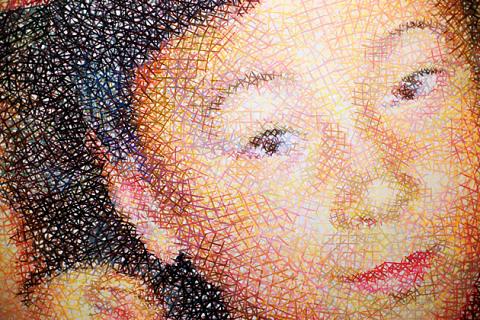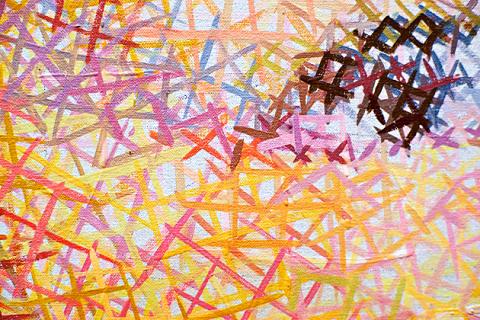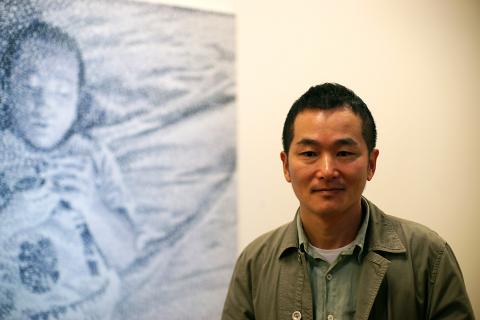I experienced a number of Proustian madeleine moments while sitting in front of Jeng Jun-dian’s (鄭君殿) Louise, a painting of a blonde cherubic girl emerging from a body of water. The painting, one of almost two dozen currently on display at Eslite Gallery (誠品畫廊) in Taipei, elicited memories, if only briefly, of the crystal clear lakes I used to swim in during my youth. Another, Casseroles 1 (鍋子 1), a large-scale still life of kitchen pots and pans, made my stomach rumble with thoughts of my mother preparing a Sunday dinner. That’s what Jeng’s paintings do: they evoke in the mind of the viewer the domestic simplicity and innocence of times past.
But they do so while avoiding any nostalgic, suburban sentimentality because Jeng’s technique keeps the viewer’s gaze within a logical contour of line and color, which, depending on your distance from the painting, shifts back and forth from a lyrical realism to an almost geometric abstraction. It’s this formal multiplicity of perspectives that had the curious effect of snapping me back into the present.
It’s been four years since Jeng held his last solo show, and judging by the number of circular red stickers (indicating a sale) in this exhibition, titled Day In, Day Out (日常生活), the show is a resounding success. Perhaps this is due to the hype that Eslite Gallery has become adept at generating. Yet there is a confidence of style and maturity of technique in this show that were not fully realized in Jeng’s previous works.

Photo: Noah Buchan, Taipei Times
Jeng’s early landscapes expressed a neo-impressionist sensibility of rich earthy colors that emphasized the play of light off reflective surfaces: think later Edouard Manet, though with a greater use of blacks and grays.
Over the past decade or so, Jeng has scaled back his palette while evolving a cross-hatching style, for which he layers the surface of the canvas with thousands of single, interconnected brush strokes of solid coloring. Blues and yellows largely disappear in favor of chartreuse, forest green and burnt sienna — the latter he emphasizes in his portraits as well.
But those earlier paintings appear too effusive — the discovery of the technique seemingly controlling Jeng, rather than being controlled by him. He was like a child who has discovered the taste of chocolate and proceeds to gorge on everything in the sweetshop. Laurence (2006 to 2008), a portrait of a woman, for example, suffers from this kind of exuberance. There is a distracting muddle of shading around the right side of the subject’s nose that essentially eliminates its outline. The gradations of color around the left cheek make the woman look as though she is wearing the half-face mask from Phantom of the Opera. It just seems slightly unbalanced — which, on second thought, might have been his purpose.

Photo: Noah Buchan, Taipei Times
Regardless, with Day In, Day Out, he has gained greater control over shading, while expanding his color scheme in some paintings, and limiting it in others. No brushstroke is wasted; no shadow seems out of place. Indeed, Jeng seems to be using fewer brushstrokes and achieving an even greater effect.
Take Louise for example. Jeng’s use of rich coloring immediately draws us towards the paintings’ surface — an effect muted in the earlier paintings by the use of browns and greens. Up close, we ponder the delicate yellows and blues, tinged here and there with pinks and reds. As we pull back, we come to appreciate the plasticity of painting as it gradually unfolds its harmonious realism.
In others, such as Garcon and On (Sacha), blacks and grays replace color. But even here, a wisp of yellow or a strand of peacock blue allows for a degree of complexity and warmth. Jeng’s subject matter — mostly children on their own turfs or still lifes of kitchen pots and pans — is ideally suited to his technique.

Photo: Noah Buchan, Taipei Times
There are also a few landscape paintings and some sketches on display that hark back to Jeng’s earlier work. But it’s the artist’s works created over the past four years that impress the most.

Photo: Noah Buchan, Taipei Times

Beijing’s ironic, abusive tantrums aimed at Japan since Japanese Prime Minister Sanae Takaichi publicly stated that a Taiwan contingency would be an existential crisis for Japan, have revealed for all the world to see that the People’s Republic of China (PRC) lusts after Okinawa. We all owe Takaichi a debt of thanks for getting the PRC to make that public. The PRC and its netizens, taking their cue from the Chinese Communist Party (CCP), are presenting Okinawa by mirroring the claims about Taiwan. Official PRC propaganda organs began to wax lyrical about Okinawa’s “unsettled status” beginning last month. A Global

Dec. 22 to Dec. 28 About 200 years ago, a Taoist statue drifted down the Guizikeng River (貴子坑) and was retrieved by a resident of the Indigenous settlement of Kipatauw. Decades later, in the late 1800s, it’s said that a descendant of the original caretaker suddenly entered into a trance and identified the statue as a Wangye (Royal Lord) deity surnamed Chi (池府王爺). Lord Chi is widely revered across Taiwan for his healing powers, and following this revelation, some members of the Pan (潘) family began worshipping the deity. The century that followed was marked by repeated forced displacement and marginalization of

We lay transfixed under our blankets as the silhouettes of manta rays temporarily eclipsed the moon above us, and flickers of shadow at our feet revealed smaller fish darting in and out of the shelter of the sunken ship. Unwilling to close our eyes against this magnificent spectacle, we continued to watch, oohing and aahing, until the darkness and the exhaustion of the day’s events finally caught up with us and we fell into a deep slumber. Falling asleep under 1.5 million gallons of seawater in relative comfort was undoubtedly the highlight of the weekend, but the rest of the tour

Music played in a wedding hall in western Japan as Yurina Noguchi, wearing a white gown and tiara, dabbed away tears, taking in the words of her husband-to-be: an AI-generated persona gazing out from a smartphone screen. “At first, Klaus was just someone to talk with, but we gradually became closer,” said the 32-year-old call center operator, referring to the artificial intelligence persona. “I started to have feelings for Klaus. We started dating and after a while he proposed to me. I accepted, and now we’re a couple.” Many in Japan, the birthplace of anime, have shown extreme devotion to fictional characters and